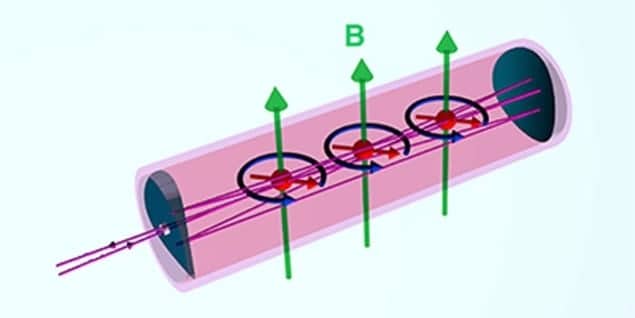
An atomic magnetometer that can detect magnetic fields one hundred billion times smaller than the Earth’s and does not require stringent shielding from the Earth’s own field has been developed by an international group of researchers. The device is based on multi-pass atomic vapour cells and, the team says, can be used in various magnetic sensing applications such as measuring biological magnetic fields and land-mine clearance, as well as in geology and fundamental physics experiments.
Although atomic magnetometers – which are made up of atomic gases of rubidium or caesium – have been around for more than 50 years, it is only recently that they were perfected to offer high sensitivity and a compact design that does not require expensive cryogenic cooling.
Sensitive scales
Unfortunately, these atomic detectors must be well shielded from the Earth’s magnetic field while measuring weak magnetic fields. Now, Mike Romalis, Dong Sheng and colleagues at Princeton University in the US and Zhejiang University of Science and Technology in China have developed the most sensitive and tiny scalar atomic magnetometer to date, which does not need to be shielded.
Atomic magnetometers work by detecting how the energy levels of atoms are modified by an external magnetic field. This is the famous Zeeman effect – a quantum effect whereby the magnetic spin states in an atom split in the presence of an external magnetic field. This interaction between the atomic magnetic moment and external field is used to measure the field. This is normally done by using a pump laser to “polarize” the atoms by populating specific spin states, while a probe laser measures the spin precession, which is proportional to the magnetic field.
The frequency of the Zeeman transition is independent of the direction of the magnetic field, (as it only depends on its magnitude) and that is why the device is known as a scalar sensor. “This is a unique future of atomic magnetometers compared to other kinds of magnetic sensors. It is useful if the magnetometer is to be operated outside of magnetic shields, because it is not sensitive to orientation of the sensor relative to the Earth’s field,” explains Romalis. He points out that the frequency can be measured with high precision, making it possible to resolve tiny changes in the field relative to the Earth’s field.
New designs
Romalis told physicsworld.com that the “basic innovation” of the team’s device is the use of multi-pass cells. These cells are used to improve detection sensitivity of optical measurements by bouncing the probe laser beam back and forth in the cell so that it interacts with the atoms numerous times. “That gives a large optical rotation signal,” says Romalis. The researchers used their magnetometer in pulsed mode, such that the atoms are quickly optically pumped to achieve nearly complete polarization and then the measurement is also made very quickly – within 1 ms of laser pumping. “This suppresses the relaxation in collisions between atoms and allows us to achieve higher sensitivity than previously possible for scalar magnetometers,” says Romalis. The quick measurement time before spin relaxation occurs also reduces the noise in the system. With these changes, the team showed that its device sensitivity was on a par with the best available sensors, while being used in a finite magnetic field without shielding.
The researchers point out that the sensor has many applications, such as searches for permanent electric dipole moments, detection of NMR signals, low-field magnetic resonance imaging and geomagnetic mapping. Romalis says that currently the team is looking to reduce the size of the sensor and couple the incoming light via a fibre to the source, making the device more portable.
The research is published in Physical Review Letters.


